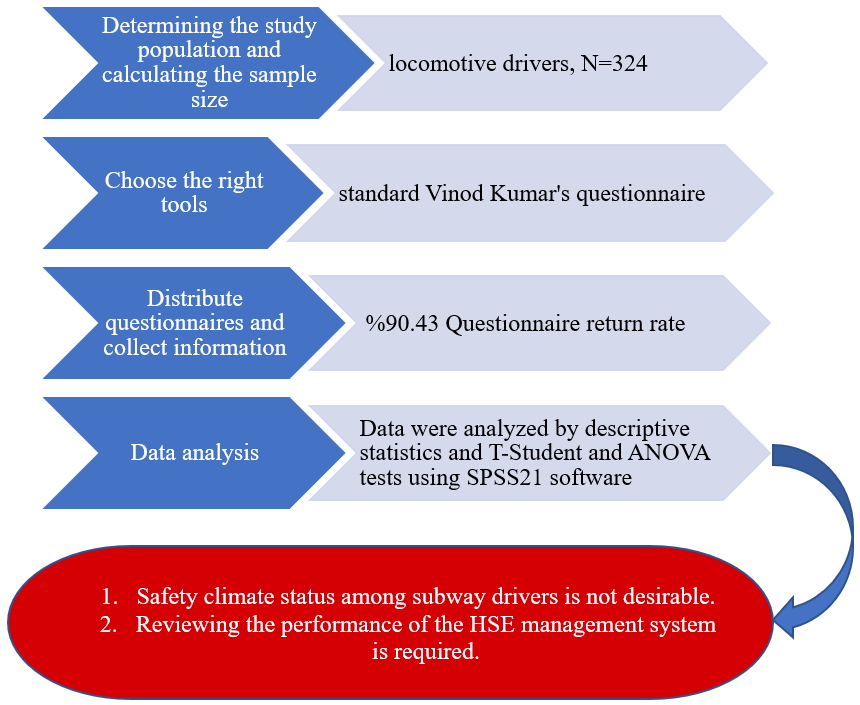Volume 10, Issue 3 (8-2020)
J Health Saf Work 2020, 10(3): 263-272 |
Back to browse issues page
Download citation:
BibTeX | RIS | EndNote | Medlars | ProCite | Reference Manager | RefWorks
Send citation to:



BibTeX | RIS | EndNote | Medlars | ProCite | Reference Manager | RefWorks
Send citation to:
Vosoughi S, Sarvari K, Chalak M H, Khandan M, Rostamzadeh S. Studying safety climate among locomotive drivers of Tehran subway transportation lines in 2013. J Health Saf Work 2020; 10 (3) :263-272
URL: http://jhsw.tums.ac.ir/article-1-6373-en.html
URL: http://jhsw.tums.ac.ir/article-1-6373-en.html
Shahram Vosoughi * 
 1, Kourosh Sarvari2
1, Kourosh Sarvari2 
 , Mohammad Hossein Chalak3
, Mohammad Hossein Chalak3 
 , Mohammad Khandan4
, Mohammad Khandan4 
 , Sajjad Rostamzadeh5
, Sajjad Rostamzadeh5 


 1, Kourosh Sarvari2
1, Kourosh Sarvari2 
 , Mohammad Hossein Chalak3
, Mohammad Hossein Chalak3 
 , Mohammad Khandan4
, Mohammad Khandan4 
 , Sajjad Rostamzadeh5
, Sajjad Rostamzadeh5 

1- Department of Occupational Health Engineering, Faculty of Health, Occupational Health Research Center, Iran University of Medical Sciences, Tehran, Iran , vosough.sh@iums.ac.ir
2- Department of Health, Safety & Environment (HSE), Tehran Metro Company, Tehran, Iran
3- Department of Occupational Health Engineering, Student Research Committee, Faculty of Health, Iran University of Medical Sciences, Tehran, Iran
4- Department of Occupational Health Engineering, Faculty of Health, Work Health Research Centre, Qom University of Medical Sciences, Qom, Iran
5- Occupational Health Research Center, Iran University of Medical Sciences, Tehran, Iran
2- Department of Health, Safety & Environment (HSE), Tehran Metro Company, Tehran, Iran
3- Department of Occupational Health Engineering, Student Research Committee, Faculty of Health, Iran University of Medical Sciences, Tehran, Iran
4- Department of Occupational Health Engineering, Faculty of Health, Work Health Research Centre, Qom University of Medical Sciences, Qom, Iran
5- Occupational Health Research Center, Iran University of Medical Sciences, Tehran, Iran
Abstract: (2268 Views)
Introduction: Safety is a significant part of the public transportation. Suitable safety climate has a positive effect on safety performance and reduces accidents rate. The aim of this study was investigating safety climate status of Tehran subway drivers in 2013.
Material and method: The present study was a descriptive and cross-sectional study. In this study, statistical population was all drivers of 1, 2 and 4 lines of Tehran Urban & Suburban Railway Operation company. Also, a questionnaire arranged by one of our researcher was used to collect demographics data of subjects. Safety climate was also investigated using standard Vinod Kumar's questionnaire. Data were analyzed by descriptive statistics and T-Student and ANOVA tests using SPSS21 software.
Results: Overall, 293 questionnaires were analyzed. Among the participants, 38.8% were line 1 derivers, 31.1% line 2 drivers and 33.1% line 4 drivers. The mean and standard deviation of the safety climate was 146.53±49.44, which is less than 147 (median). The results indicated that safety climate had a relation with the age group and education levels (P<0.01), while had no significant relationship with the deriving experience, and also marital status (P>0.05).
Conclusion: Safety climate status among subway drivers is not desirable. Among the various factors, commitment and performance of management in the safety area had the weakest status. Strengthening the structure of the health, Safety and Environment (HSE) management system in the Tehran Urban and Suburban Railway Operation company can enhance the level of safety climate among staff of this organization.
Material and method: The present study was a descriptive and cross-sectional study. In this study, statistical population was all drivers of 1, 2 and 4 lines of Tehran Urban & Suburban Railway Operation company. Also, a questionnaire arranged by one of our researcher was used to collect demographics data of subjects. Safety climate was also investigated using standard Vinod Kumar's questionnaire. Data were analyzed by descriptive statistics and T-Student and ANOVA tests using SPSS21 software.
Results: Overall, 293 questionnaires were analyzed. Among the participants, 38.8% were line 1 derivers, 31.1% line 2 drivers and 33.1% line 4 drivers. The mean and standard deviation of the safety climate was 146.53±49.44, which is less than 147 (median). The results indicated that safety climate had a relation with the age group and education levels (P<0.01), while had no significant relationship with the deriving experience, and also marital status (P>0.05).
Conclusion: Safety climate status among subway drivers is not desirable. Among the various factors, commitment and performance of management in the safety area had the weakest status. Strengthening the structure of the health, Safety and Environment (HSE) management system in the Tehran Urban and Suburban Railway Operation company can enhance the level of safety climate among staff of this organization.
Type of Study: Research |
Received: 2020/09/15 | Accepted: 2020/08/31 | Published: 2020/08/31
Received: 2020/09/15 | Accepted: 2020/08/31 | Published: 2020/08/31
Send email to the article author
| Rights and permissions | |
 |
This work is licensed under a Creative Commons Attribution-NonCommercial 4.0 International License. |




